Bernard Montgomery Worksheets
Do you want to save dozens of hours in time? Get your evenings and weekends back? Be able to teach about Bernard Montgomery to your students?
Our worksheet bundle includes a fact file and printable worksheets and student activities. Perfect for both the classroom and homeschooling!
Resource Examples
Click any of the example images below to view a larger version.
Fact File
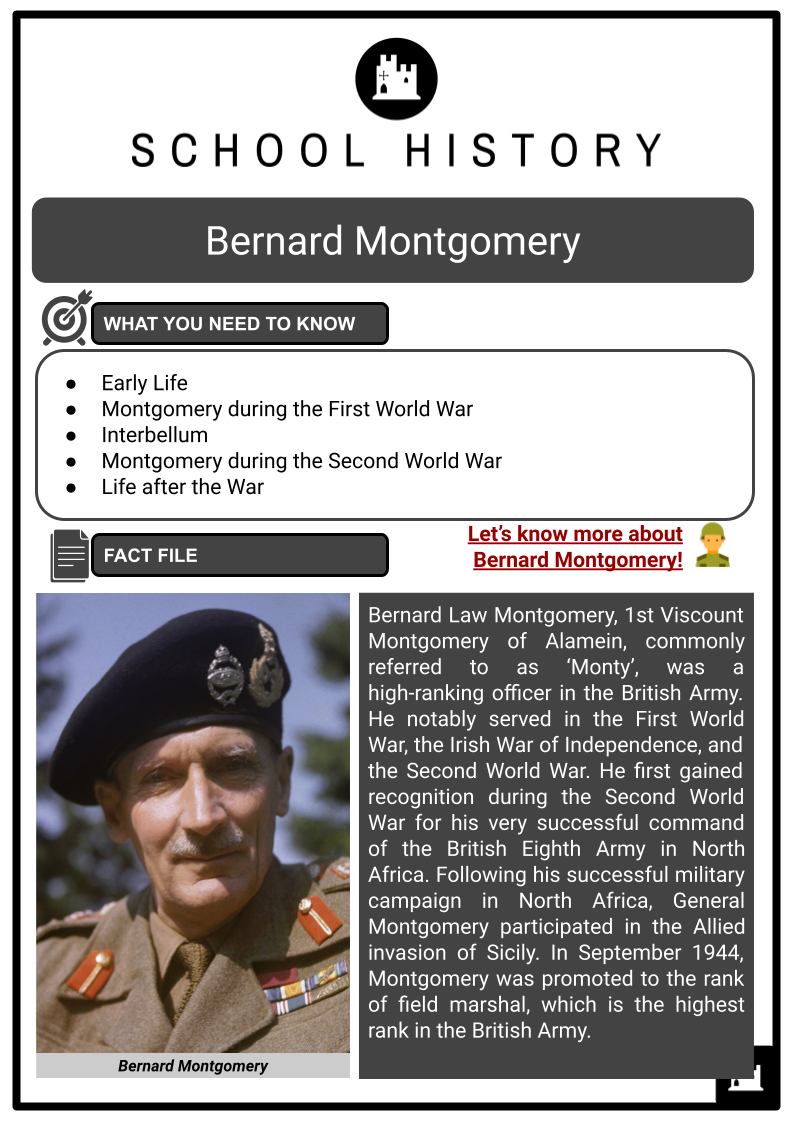
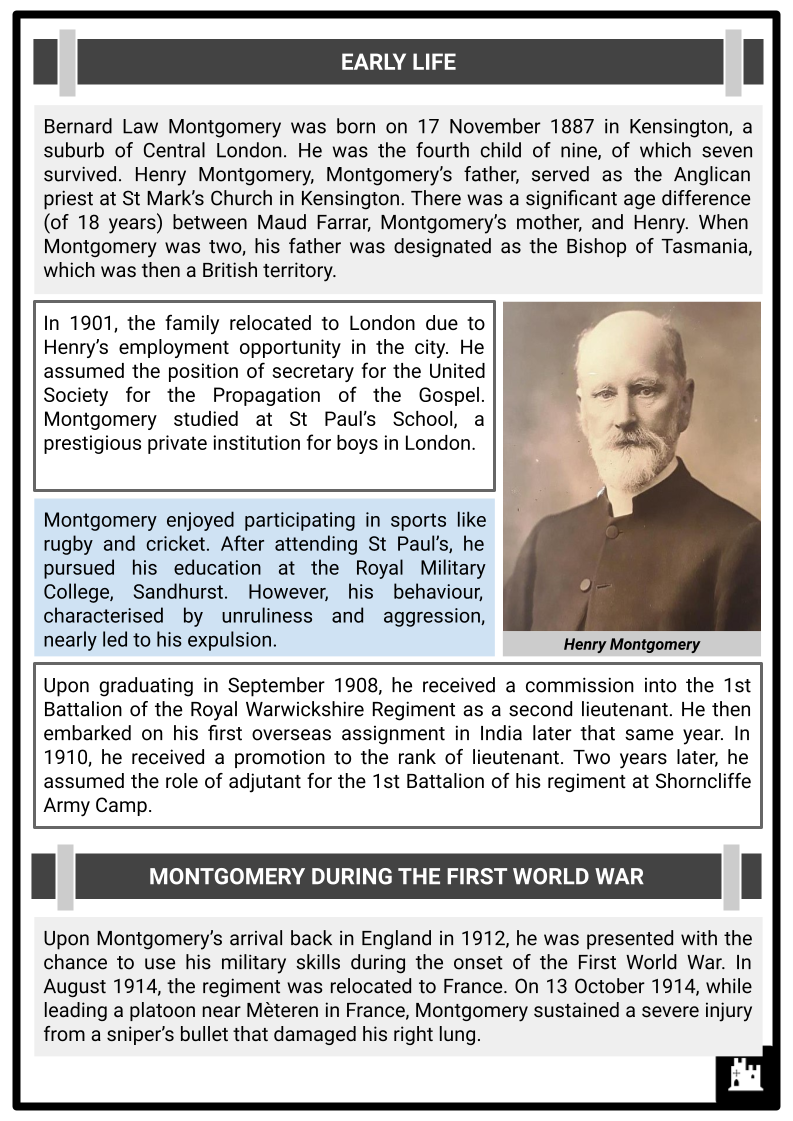
Student Activities

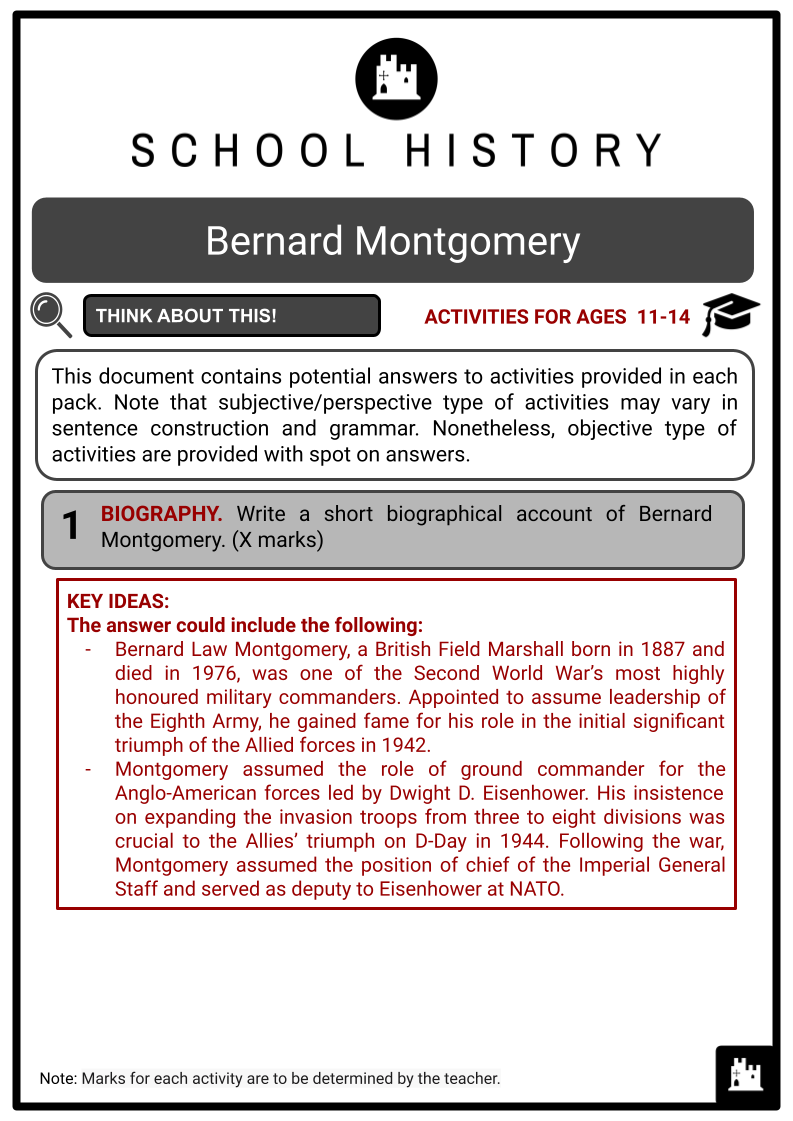
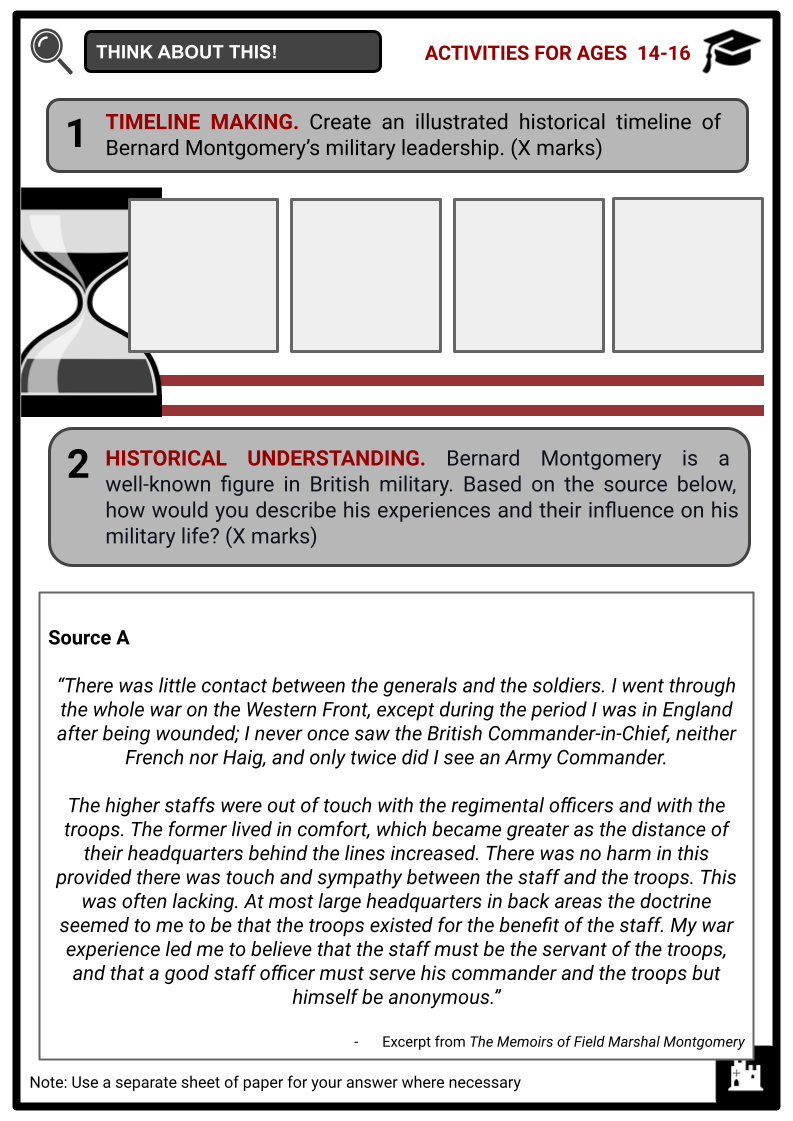
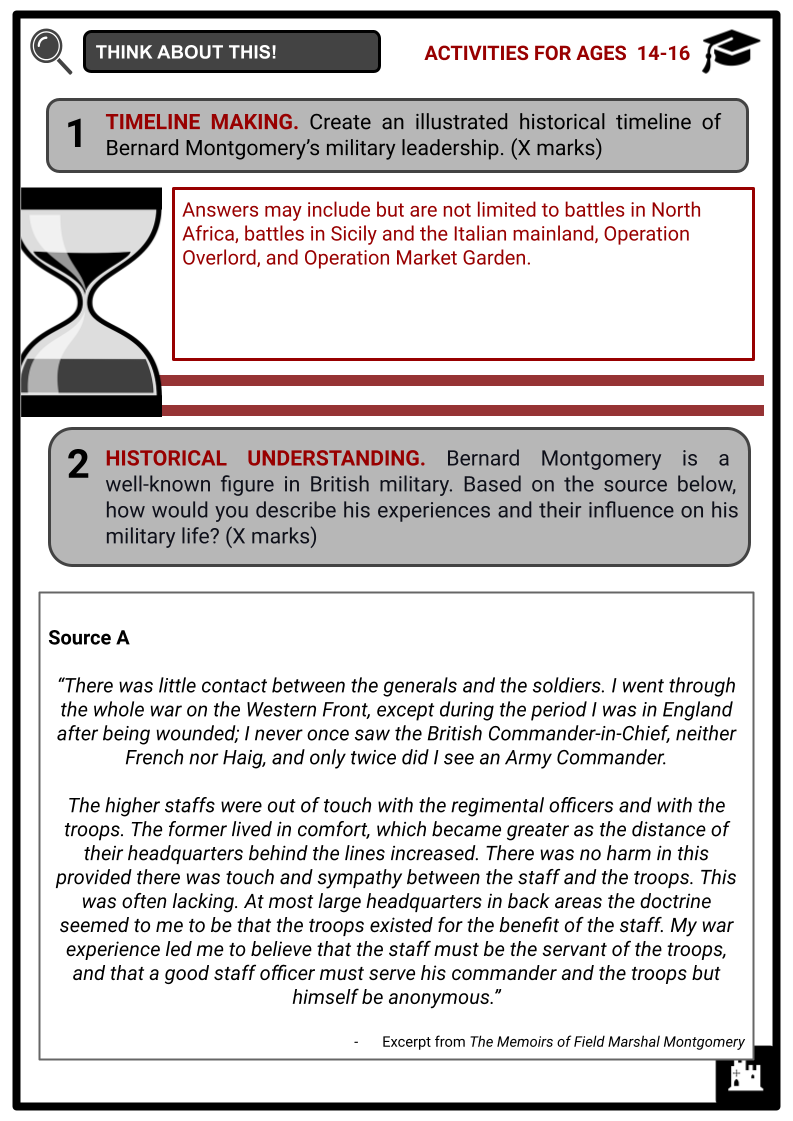
Summary
- Early Life
- Montgomery during the First World War
- Interbellum
- Montgomery during the Second World War
- Life after the War
Key Facts And Information
Let’s know more about Bernard Montgomery!
Bernard Law Montgomery, 1st Viscount Montgomery of Alamein, commonly referred to as ‘Monty’, was a high-ranking officer in the British Army. He notably served in the First World War, the Irish War of Independence, and the Second World War. He first gained recognition during the Second World War for his very successful command of the British Eighth Army in North Africa. Following his successful military campaign in North Africa, General Montgomery participated in the Allied invasion of Sicily. In September 1944, Montgomery was promoted to the rank of field marshal, which is the highest rank in the British Army.
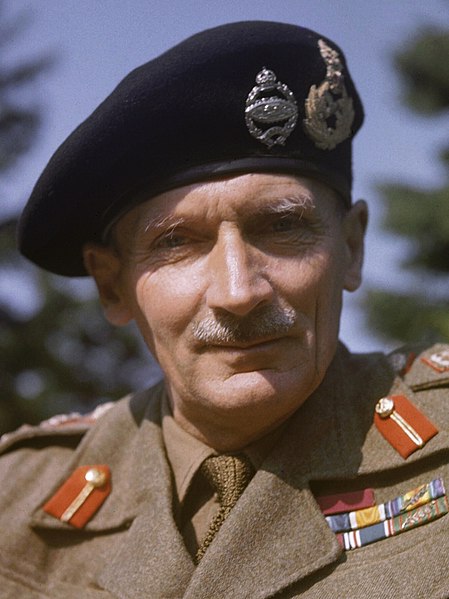
EARLY LIFE
- Bernard Law Montgomery was born on 17 November 1887 in Kensington, a suburb of Central London. He was the fourth child of nine, of which seven survived. Henry Montgomery, Montgomery’s father, served as the Anglican priest at St Mark’s Church in Kensington. There was a significant age difference (of 18 years) between Maud Farrar, Montgomery’s mother, and Henry. When Montgomery was two, his father was designated as the Bishop of Tasmania, which was then a British territory.
- In 1901, the family relocated to London due to Henry’s employment opportunity in the city. He assumed the position of secretary for the United Society for the Propagation of the Gospel. Montgomery studied at St Paul’s School, a prestigious private institution for boys in London.
- Montgomery enjoyed participating in sports like rugby and cricket. After attending St Paul’s, he pursued his education at the Royal Military College, Sandhurst. However, his behaviour, characterised by unruliness and aggression, nearly led to his expulsion.
- Upon graduating in September 1908, he received a commission into the 1st Battalion of the Royal Warwickshire Regiment as a second lieutenant. He then embarked on his first overseas assignment in India later that same year. In 1910, he received a promotion to the rank of lieutenant. Two years later, he assumed the role of adjutant for the 1st Battalion of his regiment at Shorncliffe Army Camp.
MONTGOMERY DURING THE FIRST WORLD WAR
- Upon Montgomery’s arrival back in England in 1912, he was presented with the chance to use his military skills during the onset of the First World War. In August 1914, the regiment was relocated to France. On 13 October 1914, while leading a platoon near Mèteren in France, Montgomery sustained a severe injury from a sniper’s bullet that damaged his right lung.
- His survival was attributed to a soldier who adeptly applied the appropriate bandages to his injuries amidst hostile gunfire. Regrettably, the soldier died during the rescue operation when he was fatally shot in the head by the sniper.
- Due to his injury, Montgomery would experience chronic dyspnea for the remainder of his life. Following his release from the hospital, he was honoured with the Distinguished Service Order in recognition of his exceptional bravery and prominent leadership.
- In early 1916, following a period in Lancashire serving as Brigade Major of the 112th and then the 104th Brigade, Montgomery went back to the front. He was appointed to a staff position and worked as an officer on the general staff of the 33rd Division for some time.
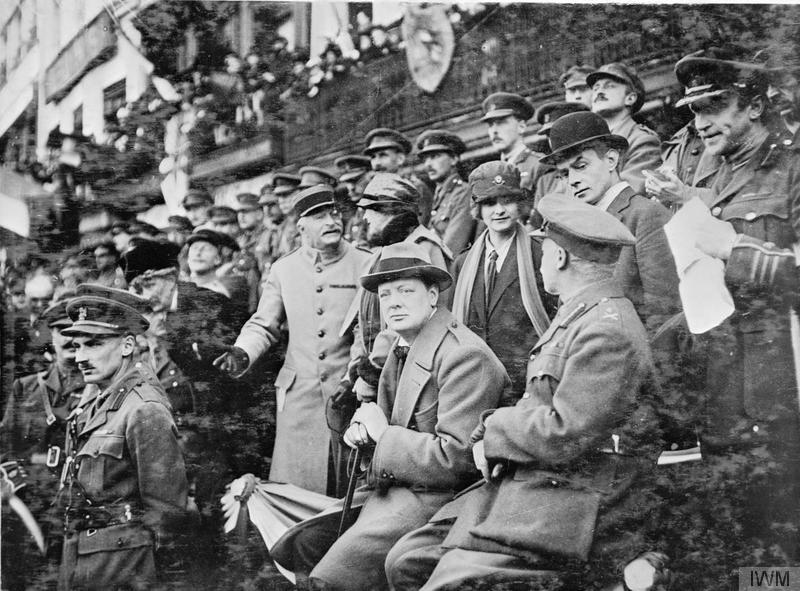
- In July 1917, he assumed the position of an officer on the general staff of IX Corps, which was a component of the 2nd Army led by General Herbert Plumer. He participated in the Battle of Passchendaele in August 1917. Montgomery concluded his military service as the Chief of Staff of the 47th Division, with the temporary rank of Lieutenant Colonel. Montgomery was deeply impacted by his wartime experiences, which influenced his perspectives toward leadership.
INTERBELLUM
- Montgomery recognised that the significant losses incurred during the First World War indicated that the current tactics were inadequate for achieving a conclusive victory. Furthermore, he was astonished by the lack of concern displayed by senior officers towards the well-being of the ordinary soldier.
- He contended that he would approach issues in an entirely distinct manner. However, during his later career, he did not introduce any significant alterations to the prevailing concepts and strategies. Following the conclusion of the First World War, Montgomery assumed leadership of the 17th Battalion Royal Fusiliers in the British Army stationed at the Rhine.
- In 1920, he enrolled in the staff course at the Staff College located in Camberley, Surrey. After finishing the course, he was sent to the 17th Infantry Brigade in January 1921 as a Brigade Major. The brigade was deployed in County Cork, Ireland and actively involved in combating the Irish Republican Army (IRA), the militant arm of the Irish nationalist movement Sinn Fein.
- In the early 1920s, a conflict erupted in Ireland between the British military and Irish separatists. The outcome of this conflict finally resulted in the establishment of Ireland as an independent nation. Following these incidents, Montgomery started attracting attention to himself. During the early 1920s, after his return from Ireland, he actively participated in the 49th Division in York. During this time, he conducted lectures and zealously drilled his troops.
- Several officers accused him of exhibiting dictatorial conduct. However, he received appreciation for his accessibility to the lower ranks and his ability to provide clear and straightforward answers. In addition, he authored an infantry manual that faced harsh criticism from specific groups, including the War Office, due to his traditionalist approach to tactics.
- In May 1923, Montgomery was sent to the 49th Infantry Division, a Territorial Army (TA) unit. In 1925, he resumed his position as a troop commander in the 1st Royal Warwickshire Regiment, and in June of the same year, he was promoted to the rank of Major. Between January 1926 and January 1929, he held the position of Deputy Assistant Adjutant General at the Staff College, Camberley, with the temporary rank of lieutenant colonel.
- In 1927, Montgomery wed Elizabeth Carver, sister of Major-General Sir Percy Hobart, who would later become a leader in the Second World War. Elizabeth had two sons, John Carver and Dick Carver, from her previous marriage to Oswald Carver.
- Dick later expressed admiration for Montgomery’s courageous decision to assume responsibility for a widow and her two children. David, the son of Montgomery to Elizabeth, was born in August 1928.
- In January 1929, he resumed his position as Commander of Headquarters Company in the 1st Royal Warwickshire Regiment.
- Later that year, Montgomery contributed to the Infantry Training Manual as one of its co-authors while working at the War Office. Subsequently, he departed for the Middle East. In 1931, he received a promotion to the rank of Lieutenant Colonel and was assigned as the commander of the 1st Battalion of the Royal Warwickshire Regiment.
- He was employed in the British mandate of Palestine and the British colony of India. In June 1934, he was elevated to the rank of Colonel. He was assigned as a teacher to the Indian Army Staff College in Quetta, which is now located in Pakistan. In June 1937, he and his family came back to England, where he was given the position of commander of the 9th Infantry Brigade, with the temporary title of brigadier.
- During the autumn of 1937, while on holiday in Burnham-on-Sea, his wife was bitten by an insect while sunbathing and subsequently had blood poisoning. Rapidly after that, this resulted in the amputation of one of her limbs and her subsequent death. Montgomery was profoundly devastated by her passing and wholeheartedly devoted himself to his military task.
- In 1938, he orchestrated a joint amphibious manoeuvre, greatly impressing high-ranking officers. In October 1938, he attained the rank of Major General. He was dispatched to Palestine with the purpose of assuming leadership of the 8th Infantry Division. During that time, there was already a significant amount of tension developing between Jews and Arabs in the British mandate of Palestine.
- An official declaration of a state of emergency was made, and Montgomery was given the command to restore order. He successfully quelled an uprising in Arabia, but in May 1939, he fell ill with a severe pulmonary ailment and had no choice but to return to Great Britain.
MONTGOMERY DURING THE SECOND WORLD WAR
- Following Montgomery’s recovery, he became the leader of the 3rd (Iron) Infantry Division in July 1939. He imposed a demanding training regimen on the soldiers under his authority. The regiment was a component of the British Expeditionary Force (BEF) under the command of John Vereker, also known as Lord Gort.
- The BEF was sent to France in September 1939 following Britain’s declaration of war against Germany.
- The 3rd Infantry Division was a component of II Corps under the leadership of General Alan Brooke. Montgomery travelled to France with great confidence and boldness. Shortly after the invasion, it became evident that the German troops, partly due to their Blitzkrieg tactics, were superior to the British and French forces. After the French Army surrendered in May 1940, the British were forced to retreat to Dunkirk.
- The officers commended Montgomery’s command of his division as an exemplary demonstration of a rear guard action under extremely challenging conditions. The issue was exacerbated when Montgomery assumed control of II Corps in the final stages prior to the evacuation.
- General Brooke relinquished leadership to him as he had received orders to return to Great Britain and assume a more senior command. Montgomery successfully guided the forces under his authority back to England without significant casualties. Upon his return, he vehemently criticised the command of the BEF for their actions during the European campaign, a matter that the War Office did not overlook.
- In July 1940, Montgomery’s promotion to the temporary rank of Lieutenant General was nevertheless granted. He was assigned to command V Corps, which had the responsibility of defending Hampshire and Dorset against the anticipated German invasion.
- During their meeting in July 1940, British Prime Minister Winston Churchill was struck by Montgomery’s forthrightness as he boldly approached the Prime Minister to request extra transportation resources. Afterwards, in April 1941, Montgomery was designated as the commander of the XII Corps, with the responsibility of safeguarding the defence of Kent.
- At this location, he exposed his soldiers to a demanding training regimen and implemented a firm stance. He promptly discharged soldiers from the military whom he deemed insufficiently capable. He considered it preferable for these soldiers to avoid dying in war.
- Upon discovering that Montgomery was compelling his staff officers to engage in regular seven-mile runs, Churchill openly expressed his dissatisfaction. In December 1941, he assumed the role of commander for South-Eastern Command, with the responsibility of safeguarding the regions of Kent, Sussex and Surrey.
NORTH AFRICA
- Montgomery assumed command of the British 8th Army in North Africa on 13 August 1942, following the unexpected appointment and replacement of General Claude Auchinleck, who was concurrently serving as the Commander-in-Chief of the Middle East Command.
- Churchill perceived only squandered opportunities, disregarding the troops’ exhaustion, and consequently replaced Auchinleck with Montgomery. General Sir Harold Alexander was designated as the Commander-in-Chief of the Middle East Command.
- On arrival in North Africa, Montgomery successfully restored the morale of the heavily damaged British soldiers. He regained their trust by frequently visiting his troops and putting them through demanding training. He intentionally ignited the blueprints for a retreat and disregarded any prior planning.
- In September 1942, Erwin Rommel, the leader of the German Afrika Korps, was compelled to initiate his withdrawal. His fuel reserves had been depleted, and the Desert Air Force was consistently targeting his troops. The initial encounter between Montgomery and Rommel took place at the intense Battle of Alam-Halfa, located to the south of El Alamein, from 30 August to 5 September 1942.
- Following the arrival of a substantial number of reinforcements, which included 300 American M4 Sherman tanks, Montgomery initiated an aggressive campaign. The initial strategy, which involved a substantial diversionary manoeuvre, proved to be ineffective.
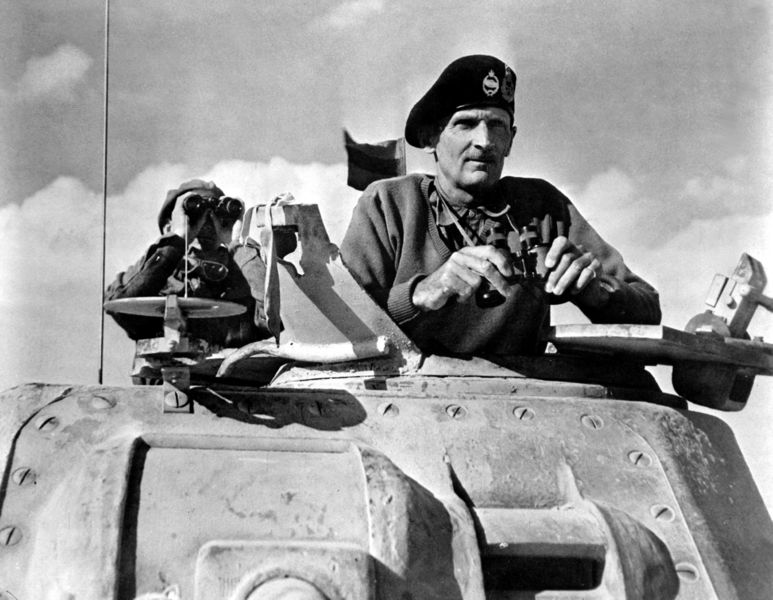
- Although facing shortages of fuel and ammunition, the German and Italian troops displayed a formidable fight. The German-Italian forces were decisively defeated and forced to retreat from the battlefield during a second offensive on 2 November 1942.
- This event was the pinnacle of Montgomery’s professional achievements and led the British superior command to provide unwavering support to him.
- British historian Sir Basil Henry Liddell Hart argues that the British triumph has been greatly exaggerated and embellished. The British people desired triumph following the losses of the preceding years.
SICILY AND THE ITALIAN MAINLAND
- Following their successful defeat of the Axis powers in North Africa, the British and Americans made preparations for an assault on Sicily. The attackers aimed to weaken the Third Reich by targeting Italy, which Churchill described as the vulnerable part of Europe.
- Montgomery objected to the early preparations for Operation Husky, the codename for the island attack. He desired to deploy his 8th Army in the southeastern region and requested Lieutenant General George Patton to protect his side. Patton disagreed with this concept, leading to friction among the Allied leaders.
- Montgomery successfully seized control of Syracuse on 1 July 1943 with no difficulties. As the Allies continued their march into Catania, the German resistance became more intense.
- Intense combat occurred in locations such as Gerbini and the River Simeto, resulting in significant casualties for the British forces. After the successful completion of Operation Husky, the Allies initiated a military campaign to invade mainland Italy.
- Montgomery’s 8th Army advanced northward along the Adriatic Sea coastline, facing obstacles due to the Germans destroying all bridges as they retreated. The American 5th Army and the British 8th Army established communication on 25 September.
- The 8th Army successfully seized control of the Foggia plateau, which provided strategically valuable airfields for conducting bombing operations against objectives located in southern Germany and Austria. In November 1943, the progress of the 5th Army came to a stop in front of the heavily constructed Gustav line, which stretched between Rome and Naples.
- Montgomery faced challenges related to the availability of resources and strong opposition from the German forces. Montgomery ceased all operations on 21 December 1943. The casualties were excessively high, and the air force had significant operational challenges due to adverse weather conditions.
OPERATION OVERLORD
- Montgomery was summoned back to Great Britain in the latter part of December 1943 to engage in the strategic organisation and groundwork for Operation Overlord, the collective military assault by the Allies on the beaches of Normandy.
- Upon the request of American General Dwight Eisenhower and Montgomery, the number of troops from the first draft was increased from three to five divisions, and the objective of capturing the Cotentin peninsula was also included.
- Montgomery assumed command of the 21st Army Group, which consisted of British and American soldiers, during the initial stages of the Normandy campaign, acting as Eisenhower’s representative.
- Patton and American General Omar Bradley were highly infuriated by the fact that an Englishman was appointed to lead American troops, as they found it incomprehensible.
- Montgomery confidently claimed that Operation Goodwood, which was launched in July 1944, would result in a more significant triumph than the one achieved at El Alamein in November 1942.
- The final instructions sent to General Miles Dempsey, the commander of the British 2nd Army, and Lieutenant General Richard O’Connor, the commander of VIII Corps, a division of the 2nd Army, were notably lacking in heroism.
- On 6 August 1944, Nazi leader Adolf Hitler compelled Generalfeldmarschall Günther von Kluge to initiate a retaliatory assault using three armoured divisions in the vicinity of Mortain, with the objective of advancing towards Avranches in order to sever Patton’s 3rd Army.
- Nevertheless, the onslaught was successfully repelled, and the Allies commenced a massive effort to surround the enemy forces.
OPERATION MARKET GARDEN
- After stabilising the situation, Eisenhower established his headquarters in mainland Europe and assumed command of all Allied ground forces. As of 1 September 1944, Montgomery’s authority was restricted to the 21st Army Group, which comprised the British 2nd Army under General Miles Dempsey and the Canadian 1st Army under General Harry Crerar.
- Montgomery was deeply distressed by this decision, even though it had been planned from the outset. The alterations in the Allied command structure were also subjected to criticism by the British press.
- The British disregarded the fact that the American war efforts were considerably more substantial than those of Great Britain, and the transfer of leadership had always been included in the planning for Operation Overlord.
- After the Allied forces retreated from Normandy, the Wehrmacht and Waffen-SS units were compelled to escape, enabling the Allied army to advance rapidly.
- Historian Robin Neillands asserts that Montgomery’s progress across France and Belgium demonstrated his mastery of military tactics comparable to that of Patton.
- Montgomery was elevated to the rank of Field Marshal. The promotion was met with dissatisfaction among American commanders, particularly Patton, as it theoretically elevated Montgomery to a higher rank than Eisenhower.
- Unfortunately, Operation Market Garden did not achieve the anticipated level of success. The mission was unsuccessful mostly due to the significant distance between the drop zones and the objectives, malfunctioning radio communication, and the unexpectedly swift response from the Germans.
- Following the unsuccessful outcome of Operation Market Garden, Montgomery persisted in advocating for the narrow front plan and emphasising the utmost need to grant absolute primacy to his 21st Army Group.
- He partially achieved his desired outcome in this situation. He was provided with extra provisions to remove obstacles at the mouth of the Scheldt. In addition, he was granted shared accountability for the American 1st Army, along with Bradley.
- Montgomery was dissatisfied with Eisenhower and frequently voiced criticism towards him. He asserted that he was better qualified to serve as the supreme commander of the ground troops.
LAST YEAR OF THE WAR
- On 16 December 1944, the Germans initiated an unexpected assault in the Ardennes region. The Germans launched an assault on a part of the front that had inadequate defences and achieved several victories during the initial days of the offensive.
- On 20 December 1944, Eisenhower convened a meeting with his army leaders to address the challenging predicament. As per customary, Montgomery was absent and instead sent his Chief of Staff.
- An action taken by Eisenhower was to temporarily subordinate the 1st and 9th Army to Montgomery’s command. Eisenhower said that the headquarters of the 12th Army Group was geographically isolated in Luxemburg, allowing Montgomery to maintain continuous communication with both armies.
- Montgomery’s hostile and stubborn demeanour exacerbated the tension among the Americans. On 17 January 1945, the 3rd and 1st Army converged at Houffalize. As a result, 1st Army was once again put under the command of Lieutenant General Bradley.
- The 9th Army remained under the command of the 21st Army Group until the River Rhine was crossed. Montgomery received instructions to go northwards towards the Ruhr Valley. In addition, he requested extra military personnel and a prominent position in the operation to cross the Rhine River.
- Montgomery was provided with additional troops from the United States. However, it was ultimately the units of the 1st Army who became the first to cross the river at Remagen on 7 March 1945. In February 1945, Montgomery initiated Operation Veritable in the southeastern region of Nijmegen.
- An action taken by Eisenhower was to temporarily subordinate the 1st and 9th Army to Montgomery’s command. Eisenhower said that the headquarters of the 12th Army Group was geographically isolated in Luxemburg, allowing Montgomery to maintain continuous communication with both armies. The German defence exhibited formidable strength, while the muddy terrain posed a significant hindrance to the advancing soldiers. The operation proved to be successful, as it resulted in the seizure of the left bank of the Rhine.
LIFE AFTER THE WAR
- Following the conclusion of the Second World War, Montgomery was designated as the commander of the Army of the Rhine, which served as the British occupation army in Germany. On 1 January 1946, he was granted the prestigious title of Viscount Montgomery of El Alamein and appointed as the Chief of the Imperial General Staff, the most esteemed military position in Great Britain.
- Montgomery maintained this role until 1948, after which he was appointed as the chairman of the permanent defence organisation of the West-European Union.
- He played a role in the formation of the North Atlantic Treaty Organization (NATO) in 1946. He served as the deputy commander of the military forces of this organisation under Eisenhower, who had become president of the United States in the meantime.
- From 1951 to 1966, Montgomery served as the chairman of the board of directors at St. John’s School in Leatherhead, Surrey. The Viscount Montgomery Elementary School was inaugurated in 1953 in Hamilton, Canada, as a tribute to him.
- Montgomery received several prestigious awards for his actions during the Second World War, including the Grand Cross of the Order of the Dutch Lion, the Grand Cross of The Most Honourable Order of the Bath, the Russian Orden Pobeda, and the Polish Order Virtuti Militari Grand Cross.
- Despite the conclusion of the war, Montgomery remained a source of ongoing dispute. Following a trip to South Africa, he expressed a positive opinion of the apartheid system.
- In addition, he expressed favourable views for Mao Zedong, the leader of China from 1949 to 1976, who is widely regarded as one of the most prolific perpetrators of mass killings in the 20th century.
- Montgomery died on 24 March 1976 at the age of 88 at his residence, Isington Mill, located in Isington, Hampshire. He was interred in the Holy Cross Cemetery located in the nearby town of Binsted.
Frequently Asked Questions
- Who was Bernard Montgomery?
Bernard Law Montgomery, often called "Monty," was a British Army officer who was one of the most prominent Allied commanders during World War II. He is best known for his leadership of the British Eighth Army in North Africa and his command of Allied ground forces during the D-Day invasion of Normandy.
- What role did Bernard Montgomery play in the North African Campaign?
Montgomery commanded the British Eighth Army during the North African Campaign, leading it to victory over Axis forces at the decisive Battle of El Alamein in October-November 1942. This victory marked a turning point in the war in North Africa and boosted Allied morale.
- How did Bernard Montgomery contribute to the Allied victory in World War II?
Montgomery's leadership was crucial in several key Allied victories, including El Alamein and the Normandy invasion. His strategic planning and command decisions helped to secure important victories and advance the Allied cause in Europe.
